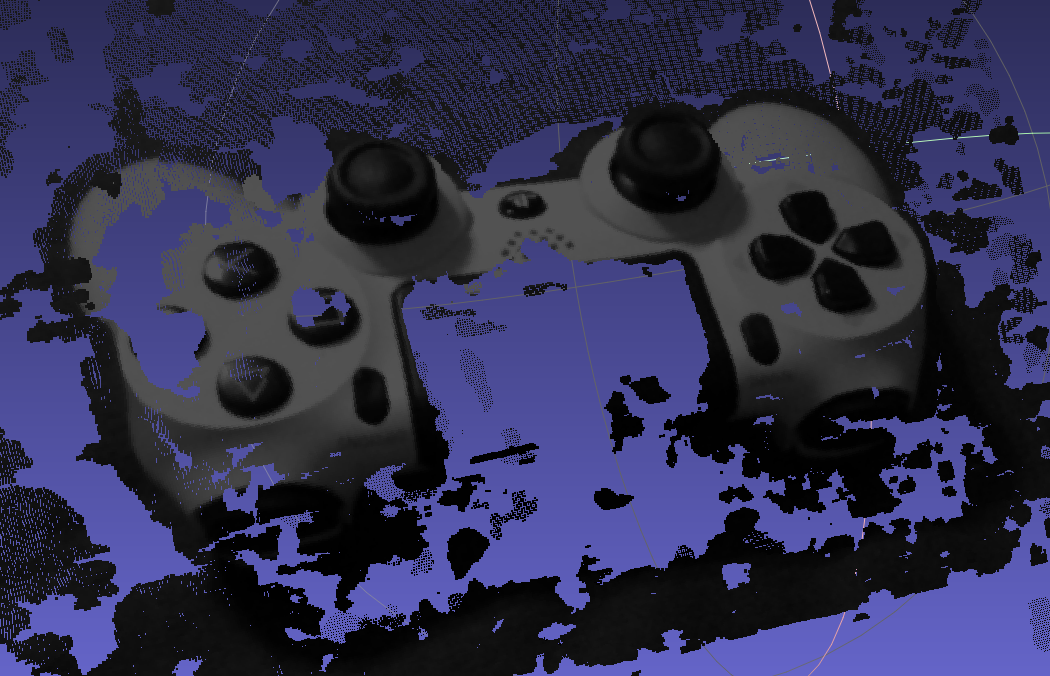Reprojecting to Disparity to 3D Point Cloud¶
Disparities maps (x-x') can be reprojected to 3d:
\begin{eqnarray} Z = \frac{fT_x}{x-x'} \end{eqnarray}During stereo calibration (cv2.stereoCalibrate()), there is a Q matrix which is produced. This can also reproject image points to world points using the cv2.reprojectImageTo3d():
Now the true 3D points are X/W, Y/W, and Z/W. If CV_CALIB_ZERO_DISPARITY is set, then $c_x = c_x'$ and the value in the lower right corner of Q is 0. Doing a little bit of algebra on the equations above leads you to:
If you look at the first equation for depth (Z) above and compare it to the last, they are the same. From a units stand point, for X, Y and Z and assuming the translation ($T_x$) units were meters (m), you end up with $\frac{m*px}{px} \Rightarrow m$. Thus your units have to be:
| Parameter | Units |
|---|---|
| Baseline ($T_x$) | meters |
| Focal length ($f$) | pixels |
| Principle point ($c_x$) | pixels |
| Disparity (d) | pixels |
You can produce the 3D points using:
cv2.perspectiveTransform(): this transforms an array of points to 3D spacecv2.reprojectImageTo3D(): this transforms a whole disparity image
import cv2
from opencv_camera import bgr2gray, gray2bgr, bgr2rgb
from matplotlib import pyplot as plt
import numpy as np
np.set_printoptions(precision=3)
np.set_printoptions(suppress=True)
ply_header = '''ply
format ascii 1.0
element vertex %(vert_num)d
property float x
property float y
property float z
property uchar red
property uchar green
property uchar blue
end_header
'''
def write_ply(fn, verts, colors):
verts = verts.reshape(-1, 3)
colors = colors.reshape(-1, 3)
verts = np.hstack([verts, colors])
with open(fn, 'w') as f:
f.write(ply_header % dict(vert_num=len(verts)))
np.savetxt(f, verts, '%f %f %f %d %d %d')
tmp = cv2.imread('image-7.png',0)
plt.subplots(1,1,figsize=(20,10))
plt.imshow(tmp, cmap="gray");
plt.title(f"image sizes: {tmp.shape}");
# get grayscale left/right image and downscale
# the image to speedup processing
tmp = cv2.imread('image-7.png',0)
_, cols = tmp.shape[:2]
imgL = cv2.pyrDown(tmp[:,:cols//2])
imgR = cv2.pyrDown(tmp[:,cols//2:])
plt.subplots(1,1,figsize=(20,10))
plt.imshow(np.hstack((imgL, imgR)), cmap="gray");
plt.title(f"image sizes: {imgL.shape}");
# grab a color version too
colors = cv2.pyrDown(cv2.imread('image-7.png'))
colors = bgr2rgb(colors)
_, cols = colors.shape[:2]
colors = colors[:,:cols//2,:]
plt.subplots(1,1,figsize=(9,9))
plt.imshow(colors);
plt.title(f"image sizes: {colors.shape}");
# disparity range is tuned for 'aloe' image pair
window_size = 3
min_disp = 16*1
num_disp = 16*8-min_disp
stereo = cv2.StereoSGBM_create(
minDisparity = min_disp,
numDisparities = num_disp,
blockSize = 16,
P1 = 8*3*window_size**2,
P2 = 32*3*window_size**2,
disp12MaxDiff = 1,
uniquenessRatio = 10,
speckleWindowSize = 100,
speckleRange = 32
)
print('computing disparity...')
disp = stereo.compute(imgL, imgR).astype(np.float32) / 16.0
computing disparity...
dm = (disp-min_disp)/num_disp
plt.imshow(dm, cmap="gray")
plt.title(dm.shape);
print('generating 3d point cloud...')
h, w = imgL.shape[:2]
t = 0.035 # baseline in meters
f = 0.8*w # guess for focal length
Q = np.float32([[1, 0, 0, -0.5*w],
[0, 1, 0, -0.5*h],
[0, 0, 0, f],
[0, 0,-1/t, 0]])
points = cv2.reprojectImageTo3D(disp, Q)
mask = disp > disp.min()
out_points = points[mask]
out_colors = colors[mask]
if 0:
out_fn = 'ps4-controller-2.ply'
write_ply(out_fn, out_points, out_colors)
print(f'{out_fn} saved')
generating 3d point cloud... ps4-controller.ply saved
Reading the ply file with meshlab shows pretty good results:

Matplotlib¶
Unfortunately, displaying in Matplotlib and spinning the pointcloud so you can see something is painfully slow. In the end, it doesn't look as good as Apple's Preview or Meshlab.
from mpl_toolkits.mplot3d import Axes3D
%matplotlib notebook
# fig = plt.figure(figsize=(20,10))
fig = plt.figure()
ax = fig.add_subplot(111, projection='3d')
ax.scatter(out_points[:,0], out_points[:,1], out_points[:,2], c=out_colors/255.0)
<mpl_toolkits.mplot3d.art3d.Path3DCollection at 0x13d7fa460>
